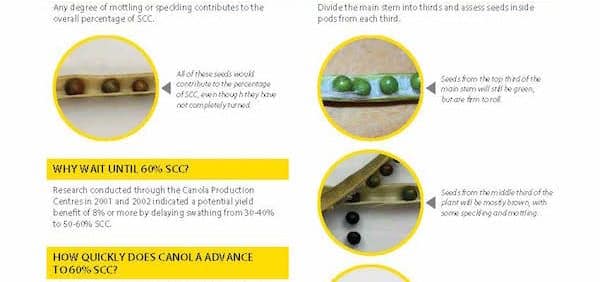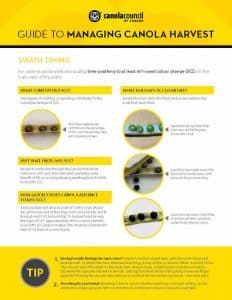What canola production practices would you like to improve for 2019? Our Top 10 covers important and timely topics to consider, with notes on upcoming presentations and links to learn more.
1. Seed technology. (1) With China’s recent approval of TruFlex, Canadian canola growers will see an expansion of the herbicide-tolerant canola options available to them. Read more. (2) The list of clubroot-resistant varieties continues to expand. (3) Though this doesn’t affect canola seed, end-point royalties have been proposed for cereals and other important rotation crops. Manitoba Canola Growers is looking for your thoughts on this proposal. At the end of CropSphere in Saskatoon, Wednesday, January 16 at 2:30, there is an open session (no CropSphere registration required) on seed royalty consultations.
2. A plan to prevent and contain clubroot. Scout for patches in 2019 and take quick measures to contain them. Use clubroot-resistant varieties. Extend canola rotations. Read more in Canola Watch. Read the CCC publication “Understanding Clubroot Resistance“. For 2019, clubroot.ca has new details on field-entry protocols and farm plans to contain/prevent clubroot. As a review of clubroot, watch this graphic video. CCC agronomy specialist Dan Orchard is part of a clubroot presentation at Ag Days in Brandon, January 22 at 10:15 a.m. Dan also presents “A growers guide to clubroot in Alberta,” at FarmTech in Edmonton, January 30 at 1:30 and January 31 at 11:30.
3. The new “Guide to Managing Canola Harvest”. Find it here. The guide quantifies the yield benefit from waiting until 60% seed colour change to swath, explains how to assess seed colour change, explains how to harvest around fall frost events, and provides tips on straight-combining canola. As part of a harvest management crash course, watch the Harvest Management & Mitigating Loss video. CCC agronomy specialist Angela Brackenreed presents “Managing difficult canola harvests” at CropSphere in Saskatoon, January 16 at 10:00 and “Measuring the dollars and cents of harvest loss” at Ag Days in Brandon on January 22 at 9:45 a.m.
4. Combine College. Each Prairie province will have a Combine College in 2019. Dates and locations are March 12 in Regina, Saskatchewan and March 20 in Brandon, Manitoba. The Alberta event will be in July, with date and location to be announced. These events will include educational sessions on the agronomy of harvest management, grain grading, harvest loss reduction, five manufacturer clinics, maintenance clinics and aftermarket combine component options.
5. Seeding rate tools at canolacalculator.ca. Use the target plant density calculator to determine a target plant stand suitable for your operation, and then the seeding rate calculator figure out the seeding rate that will achieve that target stand. Read the Canola Digest article “What is the most economical seeding rate?”, which stemmed from an important discussion at Canola Discovery Forum 2018.
6. Biodiversity benefits the farm business. Over 2,000 beneficial insects call canola fields and surrounding habitat home. Canola Digest described how biodiversity benefits the farm in a few articles over the past couple of months: Non-farmed spaces have real value. Use biodiversity to your advantage. CCC agronomy specialist Gregory Sekulic tackles this topic in his presentation at CropSphere in Saskatoon, January 15 at 3:45.
7. Keep It Clean. Everyone has a part to play in keeping canola and all other harvested crops in top shape for export. At CropSphere, CCC v.p. Brian Innes is part of a panel speaking on “Protecting Global Markets – Importance of Keeping it Clean!” It goes Tuesday, January 15 at 11:25 and again Wednesday, January 16 at 1:30. If you’re at the Crop Production Show in Saskatoon that same week, stop by the Keep It Clean booth – near the SaskCanola booth – and take our quiz. Read our Keep It Clean tips.
8. Fertilizer rates and placement. Dry seedbed conditions in 2018 reminded many growers about the risk of extra seed-placed fertilizer. Canola Digest had two articles on the topic of fertilizer and the 4Rs. January 2019 Canola Digest article called “What fertilizer practices are the worst for losses.” The Science Edition 2018 had “Aim for improved nitrogen-use efficiency.”
9. The annual Canola Watch exam. CCAs and CCSCs who get 70% or better will get 6 credits, but anyone can take the exam. It’s free and a provides a quick review of your canola agronomy skills. The answer key will be posted after January 31.
10. Our new publication “Understanding Blackleg Resistance”. The PDF publication lists these six blackleg management steps: (1) Grow canola varieties with a Resistant (R) or Moderately Resistant (MR) field rating; (2) Practice a diverse crop rotation with at least two years between canola crops; (3) Scout for the disease across fields; (4) Use a different resistance group or source to target the blackleg races within the field; (5) Consider an early-season fungicide application; and (6) Manage brassica weeds and volunteer canola, which can host the pathogen. The publication goes into detail on how to make use of the new blackleg resistance classification for seed varieties. If you’re at Ag Days in Brandon on January 22, listen to CCC agronomy specialist Justine Cornelsen’s presentation on using blackleg race ID testing to select hybrids. While at Ag Days, stop by the CCC/MCGA booth on the arena concourse.
Read more about the CCC new directions for 2019

